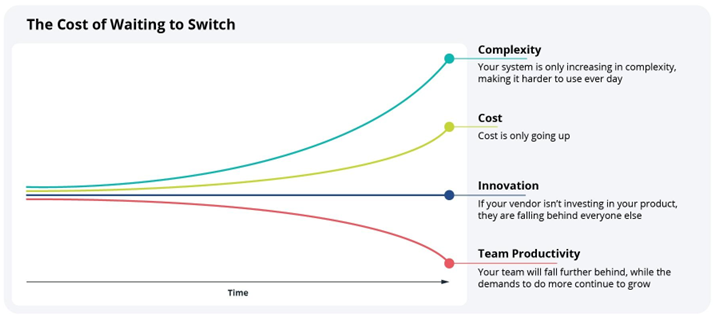It feels like marketing leaders have more, every day, on their to-do lists. Not to mention the challenge of budgets being cut while targets remain the same (or even grow!).
And even though both meeting those goals and driving growth demand more and more efficiency, martech seems to be leading us in the opposite direction.
A Gartner study of 400+ marketing leaders found that their utilization of their Martech stack's capabilities on average dropped to just 33% in 2023—the second consecutive year of decline (down from 42% in 2022, and 58% in 2020).

What's behind that decline?
The answer: the "feature functionality race." Martech vendors, racing to build bigger and better features, ended up with so much "extra stuff" in their suites that getting even the most basic work done—let alone anything complicated—became difficult.
In short, "feature bloat."
And the result is frustration and wasted time.

You feel it, right? We hear the frustration from many, many marketers.
Efficiency Is Taking a Hit
Frustration is one thing, but the deeper problem is that your efficiency is quietly eroding.
It's true. Marketers aren't fully using their entire martech stacks. But to be clear, I'm not saying you should.
For example, maybe you need your marketing automation tool to include email marketing, lead management, campaign management, analytics, and reporting, but social media marketing isn't a priority for the tool functionality.
In other words, the question isn't "How do I use more of my martech stack (or a specific tool, such as marketing automation)?" Because there are features and functionalities in your tool that might not be of value to you.
Instead, we should all focus on accomplishing what we need to get done—with maximum efficiency.
So, if you aren't fully utilizing your tools, are you doing the tasks you need to do most efficiently, or is there a better way or more efficient tools to help you reach your goals?
The 'Mega-Vendor Tax' and Opportunity Costs
Even when knowing that your existing marketing automation solution isn't working, it's tempting to kick the can down the road.
Why?
It can seem risky to make a change. And because the pain of making a change needs to outweigh that of staying the course, you need to reach a tipping point.
The problem is that many have reached the tipping point without knowing it.
Using marketing automation that isn't a fit anymore has hidden costs. Those costs show up as wasted time, missed delivery goals, frustration around UX issues, slow campaign time-to-market, and dead ends because of solutions that are no longer innovative.
But the problem is that the longer you wait to make a change, the larger the gap grows between what you want to do and what you're able to do.
A good analogy is a messy garage. You can't park your car or find anything you need. The sooner you clean it out, the sooner it becomes operational again.
For marketing leaders, the messy garage is the "mega-vendor suite tax."
Marketing teams often purchase an entire suite of products. Once you're locked into that suite, vendors can make it hard to change, and they're often continually attempting to cross-sell and upsell. And that's before we get hit with unexpected rate hikes.
You know what I'm talking about, right?
You get a year at an introductory price, with a specific number of users to get started. After your contract is up, your rate goes up, hitting your budget (especially when the tool no longer supports your efficiency goals). In addition, many vendors charge you by how many contacts you have in the system, whether you are using them or not, forcing users to play games by deleting users before the contract renewal. "Mega-vendor tax!"

Cleaning House: How to Pivot
As marketing leaders, we need to go through cycles of simplification. We often use the same tools for long periods, adding programs and assets, rules and contacts, and all sorts of stuff—additional features and buttons and steps.
Waiting too long to clean house often leaves marketing leaders discovering they're not fully utilizing their martech stack, and an obvious symptom is user frustration.
But how do you clean house?
In the product marketing world, we know there are must-have and nice-to-have features. As you look at your marketing automation solution, return to those must-have features and make sure they're as clean and efficient as possible. Ensure the tools are intuitive for users and don't slow your team down.
A few questions to ask:
- How much of this suite do we really need?
- What's the total cost of ownership (TCO)?
- Where is the balance point between what we need and TCO?
- Can we reduce the TCO and maintain operational efficiency?
By the way, the answer to that last question is often yes.
Innovating Into the Future
Looking again at that utilization statistic: If only 33% of marketers fully utilize their Martech stack, is it possible you're using the wrong tool?
Possibly.
Sure, at the start your solution was likely a good fit. But technology evolves fast, and what was right five years ago can quickly become a roadblock. That's especially true of a marketing automation tool that is no longer innovating to keep pace with your marketing needs.
So, identify the capabilities that are really important to get your job done, make those tasks super-efficient, and ensure that you're spending only in those specific areas.
Because let's face it: There is massive complexity in many marketing automation tools. And that is the opposite of what martech tools, such as marketing automation, are meant to do. We are ready for a revolution back to clean UX that drives efficiency.
If you're feeling limited by your current platform, or just frustrated, we've got you covered! Check out our marketing automation assessment to see if it's time to consider another solution.
This article is written by Jeff Day, SVP of Marketing, Act-On.




